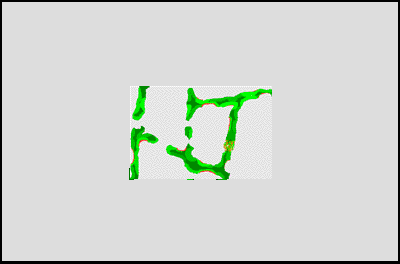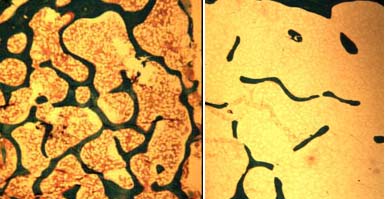
Click in the frame to see the movie. It may take a minute to load. This movie is 508 kb.



Click in the frame to see the movie.

Click in the frame to see the movie.


|
This movie shows what happens when estrogen is too low. Estrogen is a hormone that becomes low during menopause in older women. Young women have low estrogen if they are too thin or have problems with their ovaries. Without estrogen, the osteoclasts become more active and dissolve more bone. You will see some little fractures in the bone, and sometimes the osteoclasts will dissolve right through a piece of bone.
Click in the frame to see the movie. It may take a minute to load. This movie is 508 kb. |

| Here is a photo of a bone taken through the microscope. The bone was from a woman who was 65 years old. This shows that the osteoclasts have dissolved a tunnel right through the piece of bone. |

| After about 15 years, the bones get so weak that they start to break. This is called OSTEOPOROSIS. On the left is normal bone and on the right bone from a patient with osteoporosis. Notice how there is not much bone (green) and there is instead lots of fat (white) and not as many bone marrow cells (pink dots). |

|
A particularly serious kind of osteoporosis is seen in people who take a medicine called prednisone. Some children have to take this medicine, too. It makes the osteoclasts dissolve more bone and the osteoblasts don't work well. Patients have lots of broken bones, especially in the back. Click in the frame to see the movie. |
| Soon this web page will have more description of what happens in people with osteoporosis. In the meantime, there are lots more details, although a little technical, on my other web page about osteoporosis. | |

| A different kind of problem happens when there is not enough calcium and vitamin D. Then the bone cells make osteoid but there is no mineral. The bone becomes soft, weak, and painful. This movie shows how the osteoid starts to get thicker. This is called OSTEOMALACIA. In children it is also called RICKETS. Click in the frame to see the movie. |

| Here is a photograph of some bone from a patient with rickets. Notice that the red osteoid is too thick and covers most of the surface of the bone. Soon this web page will have more about rickets. In the meantime, here are details, although a little technical, on my other web page about rickets. |
Updated 9/21/01